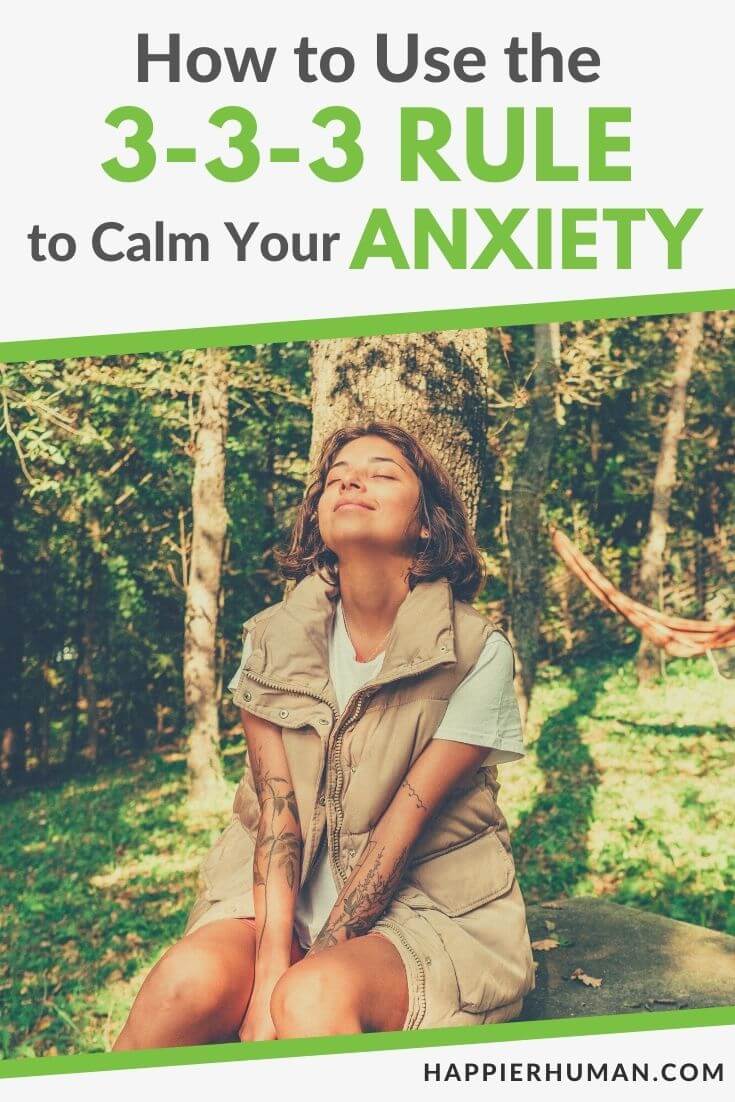If you live with anxiety, you know how difficult calming your mind can be. Anxiety can make it hard to concentrate, sleep, or even get through your day-to-day activities.
Fortunately, many techniques can help calm your mind when anxiety strikes. One of these techniques is known as the 3-3-3 rule for anxiety. In this article, we’ll talk about what it is, how to use it, and how it can help you in your day-to-day life.
What Is Anxiety?
First of all, it’s normal to have occasional worries and anxieties. Life gets complicated and sometimes throws you for a loop. So no one is immune to problems that cause stress and fear. In fact, anxiety is a normal evolutionary response to danger or stress.
However, you could be suffering from an anxiety disorder if you regularly suffer from overwhelming fear and worry. If you’ve been experiencing symptoms for longer than six months or they’re interfering with your life, it may be due to anxiety.

People with anxiety disorders may find it hard to focus at work or school and have difficulty functioning because of crushing anxiety. Living life to the fullest is hard when fear and worry take over your thoughts.
Anxiety may even cause you to withdraw from opportunities, relationships, or social events. Such activities may be a source of anxiety triggers, which can differ from person to person. Triggers could be big or small things, like:
So how do you know if what you’re experiencing is natural stress over a new situation or an anxiety disorder?
Symptoms of anxiety can be mental or physical. With anxiety, you may have an overall sense of dread or doom, even when there’s no imminent danger. You may be irritable, nervous, and tense.
You might be unable to stop thinking about worst-case scenarios, overtaken with fear about the future, or caught thinking about the past.
Physical symptoms of anxiety can also be powerful and debilitating. Anxiety symptoms include hyperventilation, sweating, a racing heart rate, shakiness, and stomach upset. You might feel disconnected from your body or short of breath, especially during a panic attack.
There are several types of anxiety disorders that result in these symptoms. For example, many people have phobias about specific situations or objects. Others may have social anxiety surrounding social situations or talking to people.
Panic disorder causes intense physical symptoms that can even feel like a heart attack. Generalized anxiety disorder is also common, causing you to experience excessive fear and worry without any definable reason.
However your anxiety manifests, you’re not alone. More than 40 million adults in the United States alone suffer from some form of anxiety and still more children under age 17. In addition, anxiety can be worse at night for some people because this is a time when there are no distractions, and you may be left alone with your thoughts.
Moving through life with symptoms of anxiety can be daunting and disheartening. You might feel powerless against anxiety when it takes hold of you.
But the good news is that there are many ways to manage or reduce anxiety and bring yourself back to the present. One way to do this is known as the 3-3-3 rule.
What Is the 3-3-3 Rule?
The 3-3-3 rule for anxiety is a simple method for bringing yourself back to your body and getting grounded. This technique is accessible because you can practice it anytime, anywhere, and all you need is yourself. The 3-3-3 rule is also straightforward enough for young children to practice.
There are three simple steps to practicing the rule of three for anxiety:
1. Name Three Things You Can See
First, look around and name three objects that are around you. It could be anything — a couch, a vase, a pet, a set of keys. Observe the characteristics of these objects without judgment, and think about their qualities.
You might ask yourself, what color is the pet’s fur? How many keys are there, and are they big or small? What sort of fabric is the couch made of?
2. Name Three Things You Can Hear
The second step is to focus on three things you can hear. Again, you’ll want to observe the details and qualities of these three sounds. Name what’s causing these sounds and note their pitch and volume.
3. Move Three Different Body Parts
Lastly, you’ll move three parts of your body around. Shake your head, wave your arms, or stomp your feet. Wiggle your fingers or your toes. Doing so will help pull you back into your body and the present moment.
That’s it — just engage three of your senses: sight, sound, and touch. Doing the 3-3-3 rule can help distract you from whatever is triggering your anxiety. It works by interrupting feelings of panic and helplessness and acting as a grounding tool.

You can even practice the 3-3-3 rule when you aren’t actively experiencing anxiety. This way, you’ll be prepared to use the technique when you need it the most in a moment of anxiety.
Much like meditation, it’s beneficial to train your mind to find calm in the storm before the storm hits.
The 3-3-3 Rule Comes From Mindfulness
The 3 3 3 rule stems from mindfulness techniques. Mindfulness is a practice of being fully aware in the present moment, purposefully connecting to what’s going on in the here and now.
Rather than focusing on the past or future, mindfulness allows us to slow down and tap into the joy of the present moment.
In this busy world, it’s easy to become entrenched in the hustle and bustle that permeates society. We often rush around from place to place, rushing to complete tasks and juggle our daily lives.
When we’re doing one task but thinking about multiple other things, we’re not fully present.
But all this rushing and doing takes its toll. It can promote stress, worsen anxiety, and lessen our happiness.
By being intentionally mindful, we can come back to ourselves and experience joy in the present moment, even when doing mundane tasks like washing dishes or driving to work.
The idea of mindfulness originates from Eastern and Buddhist philosophy. But its benefits are scientifically proven and can positively impact many aspects of your life.
Mindfulness practices could include meditation, practicing gratitude, reciting mindfulness affirmations, breathing techniques, or methods like the 3-3-3 rule.
Other Ways to Calm a Chaotic Mind
Similar to the 3-3-3 rule is the 5-4-3-2-1 method. This technique also taps into the grounding power of the five senses. With 5-4-3-2-1, you just name five things you see, four things you can touch, three sounds you hear, two smells you observe, and one taste.
There are several other grounding techniques that help with anxiety. For instance, you might engage your sense of taste by drinking a glass of water. Tap into your sense of touch by walking barefoot on the grass and connecting with the earth.
Pet your cat or dog, or listen to music. All of these can be useful practices for self-care and calming anxiety.
The Dangers of Unmanaged Anxiety
It's essential to seek the help you need if you’re suffering from anxiety. This is because unmanaged anxiety can negatively impact so many areas of your life. Anxiety can make it difficult to complete certain tasks and decrease your quality of life if left untreated.
Not only this, but anxiety and depression often go hand in hand. They can share many of the same symptoms. Both can cause insomnia, trouble with relationships, and lessen your sense of wellbeing.
Anxiety can negatively impact your physical health. Chronic stress is proven to affect almost every body system. Living with anxiety and stress can increase your risk of having health problems.
It could affect your heart, your immune system, and your gastrointestinal system. High stress and chronic anxiety can also put you at higher risk of getting sick from colds and viruses.
How to Treat Anxiety
Fortunately, there are many anxiety treatments available. Medication and psychotherapy are often very helpful. Lifestyle changes are also effective for reducing anxiety and getting back on the path to a fulfilling life.
Simple changes like reducing your caffeine intake, sticking to a regular and relaxing bedtime routine, and getting more exercise can help.
The body and mind are very much interconnected. Eating a balanced, healthy diet is essential for both mental and physical health.
Also, it’s helpful to educate yourself about your anxiety disorder and realize that it does not define you. Your thoughts can feel very powerful, but you are not your thoughts.
Cognitive behavioral therapy is one way to learn how to reset your thoughts and train your brain to think more positively. It can also provide you with healthy stress coping techniques.

Practicing the 3-3-3 rule is just one way to bring yourself back to your body and the present moment and look at your surroundings in a nonjudgmental way. Practicing yoga, Tai Chi, or meditation can also reduce stress and ground your body and mind.
It can be hard to reach out to other people when you’re struggling. But if you’re dealing with anxiety or depression, it’s important to seek the support you deserve. You don’t have to go through this alone!
If you think you have an anxiety disorder, it’s worth talking to your doctor or someone you trust. They may be able to provide resources, refer you to a support group, or just lend an open ear. Many people have anxiety, and it can be a relief to talk to others who have gone through the same things.
Final Thoughts on Anxiety and the 3-3-3 Rule
If you’re suffering from anxiety, it’s worth seeking help for your symptoms. There is no shame in it… and often, the sooner you address it, the easier it is to manage.
Luckily, you don’t have to wait to take steps to reduce your anxiety by starting at home. The 3-3-3 rule is an easy, quick, and accessible technique to get grounded that anyone can use.
By tapping into your senses of sight, sound, and movement, you can reach a more peaceful state of mind even with anxiety. For help dealing with a child suffering from anxiety, read our article on calming activities for children with anxiety.


